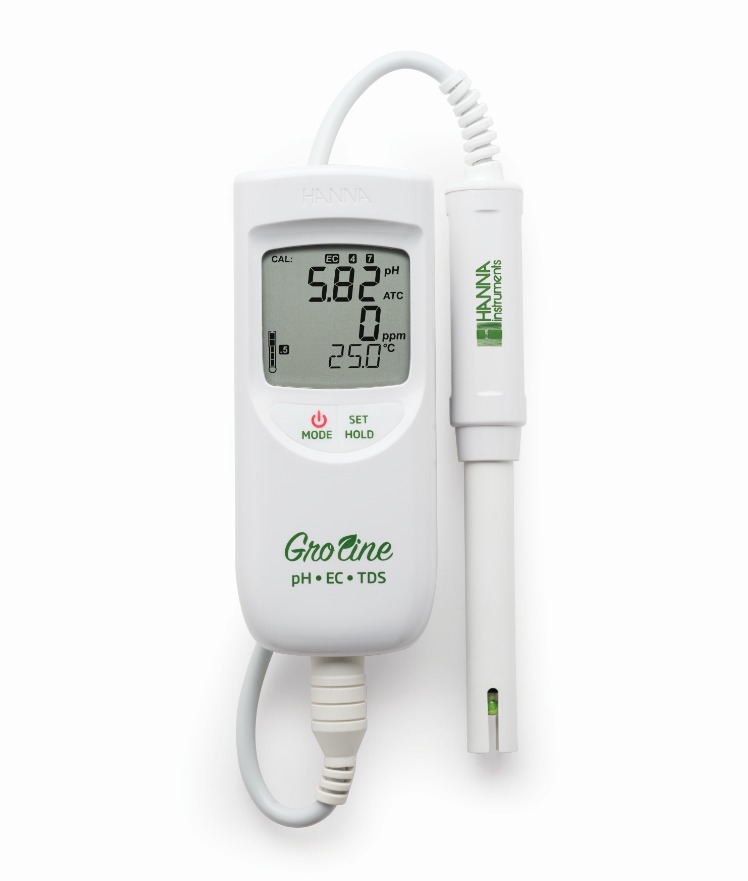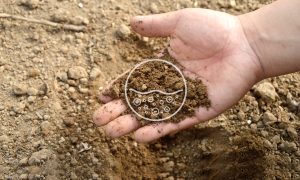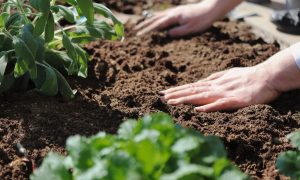Electrical conductivity (EC) is a measure of the ability of soil to conduct electrical current that is expressed in milliSiemens
or deciSiemens per meter.
Mapping EC throughout a field yields comprehensive illustrations of diverse
soil characteristics that are highly correlated to crop productivity.
Soil properties that affect EC include: soil particle size distribution, soil organic matter, soil nutrient levels, soil compaction, soil drainage, soil water holding capacity, and soil salinity.
The origin of the electrical conductance lies in charged particles within materials. These particles, on an electrical microscopic scale, are loosely positioned within substances, enabling the transmission of electric charge. Liquid water is a conductor because under natural conditions, it contains dissolved ions which are movable charged particles.
Soil, the other material that concern us here the most, is a composite conductor in which water, solid particles, and air are present in variable quantities and arrangements, and in which the electric charge carriers are water dissolved and solid particle loosely adsorbed ions. These ions are, specifically, the major inorganic ions in the aqueous systems of the earth crust, i.e., cations Na+, Mg2+, Ca2+, and K+, and anions Cl−, SO42−, HCO3−, CO32− and NO3−.
There are two main types of conductivity relevant to agriculture:
Farmers and agronomists can use the information obtained from conductivity measurements to:
Different plants have different suitable soil EC values according to the characteristics of fertilizer requirements and different growth stages. The optimal EC value for plant growth is usually between 0.8-1.8, and should not exceed 2.5
The following table is the adaption range of EC value of some common crops for reference
|
Crop |
Soil EC |
Crop |
Soil EC |
|
African Violet |
1.0-1.2 |
Lavender |
1.0-1.4 |
|
Asparagus |
1.4-1.8 |
Leek |
1.6-2.0 |
|
Anthurium |
2.0-2.5 |
Lettuce-Fancy |
0.3-0.8 |
|
Balm |
1.0-1.4 |
Lettuce-Head |
0.6-1.4 |
|
Banana |
1.8-2.2 |
Melons |
1.0-2.2 |
|
Basil |
1.0-1.4 |
Mint |
1.0-1.4 |
|
Beans |
1.8-2.5 |
Mustard Cress |
1.2-2.4 |
|
Beetroot |
1.4-2.2 |
Onion |
1.8-2.2 |
|
Blueberry |
1.8-2.0 |
Parsley |
0.8-1.8 |
|
Broccoli |
1.4-2.4 |
Passion Fruit |
1.6-2.4 |
|
Bromeliad |
0.8-1.0 |
Pea |
1.4-1.8 |
|
Brussel Sprout |
1.8-2.4 |
Pumpkin |
1.4-2.4 |
|
Cabbage |
1.4-2.4 |
Radish |
1.2-2.2 |
|
Capsicum |
2.0-2.7 |
Rhubarb |
1.6-2.0 |
|
Carrot |
1.4-2.4 |
Roses |
1.8-2.6 |
|
Cauliflower |
1.5-2.4 |
Sage |
1.0-1.6 |
|
Celery |
1.2-2.2 |
Spinach |
1.8-3.5 |
|
Chives |
1.6-2.4 |
Silver-beet |
1.8-2.4 |
|
Cucumber |
1.8-2.2 |
Squash |
1.8-2.4 |
|
Roses |
1.8-2.2 |
Strawberry |
1.8-2.5 |
|
Eggplant |
0.8-1.5 |
Thyme |
1.2-1.6 |
|
Endive |
1.0-1.4 |
Tomato |
2.2-2.8 |
|
Fennel |
1.4-1.8 |
Garlic |
1.4-1.8 |
Various methods are at your disposal for accessing the electrical conductivity of your soil. You have the option to examine the conductivity of the pore water within soil, gauge the total or bulk conductivity of the soil, or generate a slurry to assess the soil’s conductivity.
Hanna Suggestion: When conducting EC measurements in soil, it’s advisable to take reading both in close proximity to the plants and at more distant points. Moisture levels, nutrient distribution, and pH can exhibit significant variations through the planted area. While this may entail some additional effort, it will prove valuable in obtaining results that more accurately reflect the conditions across your planting area.
Appropriate instruments to determine EC in soil
HI98331
Direct Soil EC Tester Soil Test™
The Soil Test™ Direct Soil Tester-HI98331 is a rugged and reliable pocket-sized tester that offers quick and accurate readings. The Soil Test™ Direct Soil Tester-HI98331 features a stainless steel penetration probe for direct measurement of conductivity in soils. With a compact size, single button operation, and automatic calibration, Soil Test is an excellent choice for taking direct conductivity measurements in soil.
HI9814
pH/EC/TDS/Temperature Meter
With Multiparameter Probe HI9814 is a durable, portable pH, conductivity, total dissolved solids and temperature meter for most measurements encountered in hydroponics, aquaponics or general agriculture applications.
All operations and settings, are made through only two buttons.
The housing is waterproof and rated for IP67 conditions.
The supplied HI1285-7 multiparameter probe measures pH, EC/TDS and temperature in one convenient, rugged probe.
Features:
- Simultaneous, pH ,EC/TDS and temperature measurements on a large three-line LCD display;
- User-friendly Design
- Watertight Connection
- Large LCD
- Durable IP67 waterproof Casing
- mV of pH measurement for electrode check
- Selectable temperature unit(°C or °F)
- Battery life indication and low batteru detection
HI98318
EC/TDS Tester
The HI98318 is our latest pocket meter for measuring the EC/TDS of a hydroponic nutrient solution. This modern looking meter is only 0.7″ thick and extremely ergonomic, fitting comfortably in your hand. The HI98318 has a very large easy to read LCD display that shows both EC or TDS and temperature along with calibration, stability and low battery indicators.
All operations are simplified to two buttons. One is for turning the meter on/off and the other for automatic one point calibration.
- Graphite Sensor for Reduced Polarization Effect
- Two-Button Operation
- Quick Calibration Mode using Hanna pH/EC Quick Cal Solution
HI98194
Multiparameter pH/ORP/EC/TDS/DO/Pressure/ Temperature Waterproof Meter
The HI98194 is a waterproof portable logging multiparameter that monitors up to 12 different quality parameters including 6 measured and 6 calculated.
The microprocessor based multi-sensor probe allows for the measurement of key parameters including pH, ORP, conductivity, dissolved oxygen, and temperature. The probe transmits readings digitally to the meter, where data points can be displayed and logged.
The HI98194 is supplied wit all necessary accessories and packaged in durable carrying case.
Have questions?
Contact a Hanna Technical Specialist at info@hannaservice.eu or using our contact form.












